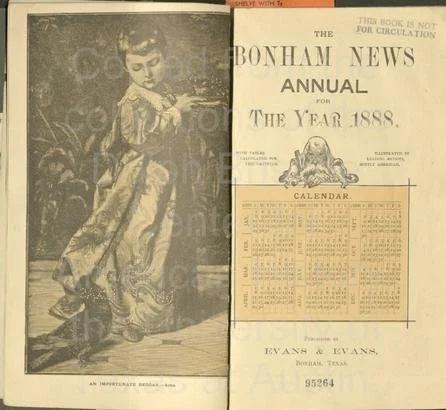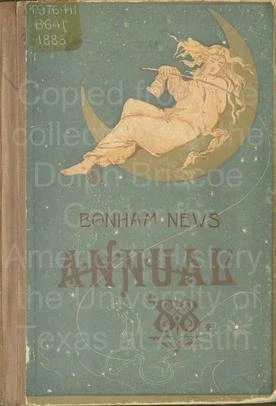Bonham News Annual 1888
One of the documents placed in the cornerstone of the Fannin County Courthouse in 1888 was the Bonham News Annual of 1888.
The copy that was actually placed in the cornerstone has not been located.
However, thanks to Kim Burpo of the Rayburn Library and the Brisco Center for American History at the University of Texas at Austin, we have obtained a scan of the document. Selected pages are transcribed on this page. The entire document can be viewed at a higher resolution HERE.
FANNIN COUNTY
Its History in Brief From its Organization to the Present Time.
Fannin County was organized in the year 1838. The first court was held at the house of Jacob Black, that being the place provided by law for holding until another location could be selected. Court convened February 26, 1838, John G. Jouett being chief justice. The attorneys present and practicing were Wm. M. Williams and Daniel Rowlett.
Administrators upon following estates were appointed:
The estates of Wm. Hoyman, Patrick Fitzgerald, Enos Murphy, WM. Howard, Anderson Clifft, Carter Clifft, Wm. Garretson, Chas. Smith, Celinder Spencer, John Roaman, James Garland, William Womack, Jas. Dalton and Eli Sweeden.
Court continued to be held at this place until July 20th, 1839, when it was held at Warren.
From the 30th of March 1840 until the 29th of March, 1841, Joseph Murphy was chief justice of the county; Mabel Gilbert and J. O'Neal, associate justices. On the 29th of March, 1841, Bailey Inglish as chief justice, held his first court. In June 1842 he was succeeded by Jas. R. O'Neal.
On the 27th of February, 1843, just six years after the organization of the county, the last court was held at Warren. On the 27th of March, 1843, Bois d'Arc having been selected as the county site, the first court was held at that place.
Thos. Jonett was clerk of the county court from its organization until the 30th of October, 1843, when he was succeeded by Roswell W. Lee.
On February 26th, 1844, the name of the county site having been changed from Bois d'Arc to that of Bonham, the first court at that place was held, with John P. Simpson (who had previously been sheriff) presiding as chief-justice.
PRODUCTS.
In the way of productions corn, cotton, broom corn, oats, wheat, barley, buckwheat, susar cane, millet, tobacco, apples, pears, peaches, plums, apricots, quinces, cherries, small fruits and vegetables of all kinds grow abundantly and yield profusely. The soil of the county is inexhaustible. The south half being the rich black waxey and the north half a deep sandy loam easy to cultivate.
The county is well supplied with an abundance of good timber, at least a sufficiency for all ordinary purposes. The growth being oak, ash, hickory, pecan, hackberry, elm, locust, mulberry, ckittam, cedar, boi'sd arc and cottonwood. Cedar being found only along the river. A quarry of limestone extends neary across the county running from the Lamar county line three miles south of Honey Grove in a western direction for about eighteen miles and extending a little west of Gober, about seven miles south of Bonham. This lime stone is easy to work, can be dressed and prepared for use with a saw and plant. It makes most excellent building material and is shipped to many places for finishing and ornamental work for fine buildings. Some of the finest store houses in the state are built of this rock. Honey Grove has ten or twelve that would be an ornament to most any city. The fine court house now going up in Bonham is being built of this stone procured from the quarries near Gober. So soon as we get the D.B. & N.O. road completed, it passing through the quarry, the stone will afford an immense article of commerce and bring to Fannin thousands of dollars. The Santa Fe already passes through the quarry near Honey Grove and the lime stone shipped from that portion of the county affords not only a source of revenue to the owners, but furnish considerable work for the road.
The year 1887 was one of universal productiveness and gives some idea of the county’s productive capacity. The season was a dry one, the rainfall being universally light. The wheat crop yielded from sixteen to thirty-nine bushels to the acre. The oat crop, owing to the exceedingly dry spring, was short, yielding only about half a crop, about forty bushels to the acre. The yield of cotton being a full average and the acreage being largely increased over former years, gave to the county about seventy-five thousand bales. In the year 1886 the county shipped a fraction over sixty thousand bales. The corn crop of 1887 was the largest ever grown, the acreage being increased and the yield much greater, being from forty to seventy-five bushels per acre, many fields yielding as high as seventy-five bushels. This, however, is the best average corn every grown in the county, but it clearly shows what can be done with ordinary good seasons and the proper cultivation. The fruit crop, owing to late frosts, was not an average one, yet thousands of bushels of apples were grown and have been sold in the market. The farmers of the county are nearly all in good spirits and in a prosperous condition, have comfortable homes and are surrounded with an abundance of all that is calculated to bring happiness and contentmeut. There is no county in Texas or any other state that offers greater inducements to the farmer.
Our lands are rich and productive; society is equal to any place. The progressiveness of our people, their love of order, good morals and intellectual development, their desire to excel in fanning, in stock raising, in education, their love of home and home comforts, their industrious habits and hospitality, all combined make them a desirable people to live among and be with.
RAILROADS.
The county will soon be a perfect net of railroads. The following are the roads at present: The Texas & Pacific railroad runs east and west through the center of the comity.
The M. K. & T. runs through the south-western portion of the county.
The St. Louis, Arkansas & Texas enters the county near the south-east corner and runs thence a little north of west, crossing the west line near Whitcwright.
The Santa Fe railroad crosses the south line of the county near Wolf City, runs thence north through the east end of the county, connecting with the Texas & Pacific road at Honey Grove.
The Denison, Bonham & New Orleans road enters the county in. the north-west portion, runs thence south-east by way of Warren and Ravenna to Bonham, all the grading being completed to the latter place. The road will be continued in a south-east direction by way of Ladonia to its connection with the Sabine & North-West road.
The contemplated roads that will, at no distant time be made, are the following: The extension of the Houston & Texas Central from Mckinney, by way of Orangeville and Bonham and thence north across Red river and on through the Indian Territory, traversing the great coal field just north of Red river.
The next road will be in the Frisco extension from Author City, entering the county at the north-east corner thereof, extending by way of Bonham, Whitewright and McKinney to Fort Worth. With these roads Fannin county will need no more, as every point will thus be made accessible, and every portion of the county will have the advantage of cheap transportation for its produce.

